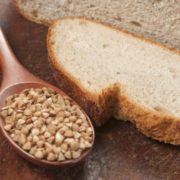Is My Fibromyalgia Pain Worse Due to Food Allergies?
 Many of my fibromyalgia and chronic fatigue syndrome (CFS) patients have undiagnosed food allergies that are contributing to their pain symptoms. I have found that eliminating these foods through special dieting has yielded significant improvement in symptoms; however, I don’t usually start this kind of diet until patients have done the Jump-Start Program for one month, are sleeping through the night, and have built a good stress-coping savings account.
Many of my fibromyalgia and chronic fatigue syndrome (CFS) patients have undiagnosed food allergies that are contributing to their pain symptoms. I have found that eliminating these foods through special dieting has yielded significant improvement in symptoms; however, I don’t usually start this kind of diet until patients have done the Jump-Start Program for one month, are sleeping through the night, and have built a good stress-coping savings account.
Eliminating potential allergic foods can be stressful, so those with sleep deprivation and depleted stress-coping accounts will find this to be an added stress.
Traditional food allergy testing is good for airborne, immediate reactions to allergens. This is usually done by skin-prick testing and RAST, which looks at IgE (the antibody responsible for immediate allergic reactions); however, there is another response that is not being looked at – the delayed response to food allergens, which can take from one hour to three days to react in the body. This is the IgG1-4 antibody.
Any testing for food allergies should be done with either the ELISA or FICA tests, which look at both IgE and IgG1-4 antibodies.
Food allergies are responsible for many symptoms associated with fibromyalgia and CFS including:
- Headache
- Eczema
- Psoriasis
- Diarrhea
- Colitis
- Asthma
- Rheumatoid arthritis
- Hyperactivity
- Gout
- Chronic pain
- Edema
- Ear infections
- Anxiety
- Depression
Allergy tests are at most 85% accurate, so I will always recommend the elimination diet as well. This is an extensive and complicated diet, but many of my patients enjoy the sense of control they get by doing this two-week elimination diet.

For two full weeks, eliminate all of the below:
- Dairy including cheese, milk, yogurt and ice cream. Butter is okay
- Corn and related products like popcorn and corn syrup
- Gluten including wheat, barley, oats, and all flour
- Soy (check list of ingredients for hidden soy)
- Nightshade foods including tomatoes, peppers, white potatoes, eggplant, and tobacco. These have a poison in them similar to belladonna and can cause joint and muscle pain.
What does that leave you? Plenty! Don’t get discouraged just yet. Alternatives are found everywhere. If you have trouble, print this post or get my book and bring it to the store with you to ask for help. I’ve found that employees in whole foods markets are more than happy to help people on diets like this.
- Substitute dairy and soy with almond or lactose- and soy-free products.
- Instead of corn, eat more green vegetables and use olive or coconut oil.
- There are plenty of options for gluten-free bread, and meats, poultry, and fish are gluten free.
- Instead of white potatoes, try sweet potatoes. Instead of tomatoes, use white sauces or other green vegetables. Stay away from peppers and “red” spices and instead use green spices like basil, oregano, mint, parsley etc.
Another approach to this diet is taking in nothing but fresh fruits and vegetables for five days, avoiding all other foods, and then start challenging in one food group at a time. Wait three days before challenging in other foods. If yeast overgrowth is an issue, eat more vegetables than fruits.
After the two weeks is up, start challenging one food group at a time, starting with dairy. For one day, take in at least three servings of dairy products while avoiding other food groups. Then go right back to the elimination diet for at least three days before challenging another food group. This is because it can take up to three days for the body to react to a food. After three days, move to the next food group for one day and then a three-day off time again.
 Keep a food diary to track foods and symptoms so you don’t lose track.
Keep a food diary to track foods and symptoms so you don’t lose track.
You can perform the pulse test and track that in your journal as well. An allergy can be determined by testing pulse rate when chewing a food or supplement. First determine your resting pulse rate (check online for ways to do this). Before taking a bite of a challenged food, record your pulse. Then put the food or drink in your mouth and chew or keep there for one minute and then expel. Take and record your pulse again.
If there is at least a 6-point rise in pulse rate (or a 1-point rise while on a strict elimination diet), then that is a positive reaction. The pulse is controlled by the autonomic nervous system, so the stress from an allergen will increase blood flow.
In any case, if you find you have had a reaction, that trigger food should be avoided for at least three to six months. You can try reintroducing it after that time, but most patients tend to stay away from them for good.
Later, we will take a look at utilizing a rotation diet to avoid developing further food allergies. The labs I refer my patients to for testing can help greatly in developing this type of diet, which will allow you to rotate certain allergic or sensitive foods in and out of your diet.
For more information about testing and the elimination diet, please see my book Treating and Beating Fibromyalgia and Chronic Fatigue Syndrome www.getfibrobooks.com
Join Me Every Week For My Free Treating and Beating Fibromyalgia Facebook LIVE @ 6pm CST
NEW PATIENT PHONE CONSULTS AVAILABLE:
ARE YOU SICK AND TIRED OF BEING SICK AND TIRED?
You can feel good again! 17 years specializing in fibromyalgia – I’ve helped thousands feel good again!Are you next?
YOU DON’T HAVE TO TRAVEL TO BIRMINGHAM AL. 90% OF MY PRACTICE IS PHONE CONSULTS.
Call 205-879-2383, or visit FibroConsults.com to schedule your consult today!
Find out more at FibroConsults.com











Leave a Reply
Want to join the discussion?Feel free to contribute!